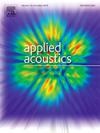Low-frequency broadband sound absorption of the Helmholtz resonator–spiral metasurface
IF 3.4
2区 物理与天体物理
Q1 ACOUSTICS
引用次数: 0
Abstract
This study proposes an acoustic metamaterial featuring a Helmholtz resonator–spiral metasurface (HRSM) to effectively achieve low-frequency broadband sound absorption. A theoretical model is developed to predict the HRSM’s sound absorption performance, and it is validated by numerical simulations and acoustic impedance tube experiments. Results indicated that the spiral metasurface of the HRSM extended the depth of the Helmholtz resonator cavity compared to the Helmholtz resonator, causing the first sound absorption peak of the HRSM to shift to a lower frequency. Additionally, the spiral channels of HRSM impeded wave propagation in the second layer, shifting the second sound absorption peak to a lower frequency, as compared to the double layer Helmholtz resonator. Optimal design was explored further in terms of diameters and lengths of the necks in the upper and lower layers of the HRSM, by taking advantage of the additive nature of absorption peaks generated by distinct units. With a structural thickness of 52 mm, the HRSM achieved closed to 90 % continuous absorption within the frequency range of 270–580 Hz, demonstrating excellent broadband absorption capabilities. This study offers an effective feasible methodology for designing sub-wavelength low-frequency broadband absorption structures.
亥姆霍兹谐振腔-螺旋超表面的低频宽带吸声
本文提出了一种具有亥姆霍兹谐振腔-螺旋超表面(HRSM)的声学超材料,可以有效地实现低频宽带吸声。建立了预测HRSM吸声性能的理论模型,并通过数值模拟和声阻抗管实验对其进行了验证。结果表明,相对于Helmholtz谐振腔,HRSM的螺旋超表面扩展了Helmholtz谐振腔的深度,导致HRSM的第一个吸声峰向更低的频率移动。此外,与双层亥姆霍兹谐振器相比,HRSM的螺旋通道阻碍了波在第二层的传播,将第二层吸声峰移至更低的频率。通过利用不同单元产生的吸收峰的可加性,进一步探索了HRSM上下两层颈部的直径和长度的优化设计。HRSM的结构厚度为52 mm,在270-580 Hz的频率范围内实现了接近90%的连续吸收,显示出出色的宽带吸收能力。该研究为设计亚波长低频宽带吸收结构提供了一种有效可行的方法。
本文章由计算机程序翻译,如有差异,请以英文原文为准。
求助全文
约1分钟内获得全文
求助全文
来源期刊

Applied Acoustics
物理-声学
CiteScore
7.40
自引率
11.80%
发文量
618
审稿时长
7.5 months
期刊介绍:
Since its launch in 1968, Applied Acoustics has been publishing high quality research papers providing state-of-the-art coverage of research findings for engineers and scientists involved in applications of acoustics in the widest sense.
Applied Acoustics looks not only at recent developments in the understanding of acoustics but also at ways of exploiting that understanding. The Journal aims to encourage the exchange of practical experience through publication and in so doing creates a fund of technological information that can be used for solving related problems. The presentation of information in graphical or tabular form is especially encouraged. If a report of a mathematical development is a necessary part of a paper it is important to ensure that it is there only as an integral part of a practical solution to a problem and is supported by data. Applied Acoustics encourages the exchange of practical experience in the following ways: • Complete Papers • Short Technical Notes • Review Articles; and thereby provides a wealth of technological information that can be used to solve related problems.
Manuscripts that address all fields of applications of acoustics ranging from medicine and NDT to the environment and buildings are welcome.
 求助内容:
求助内容: 应助结果提醒方式:
应助结果提醒方式:


